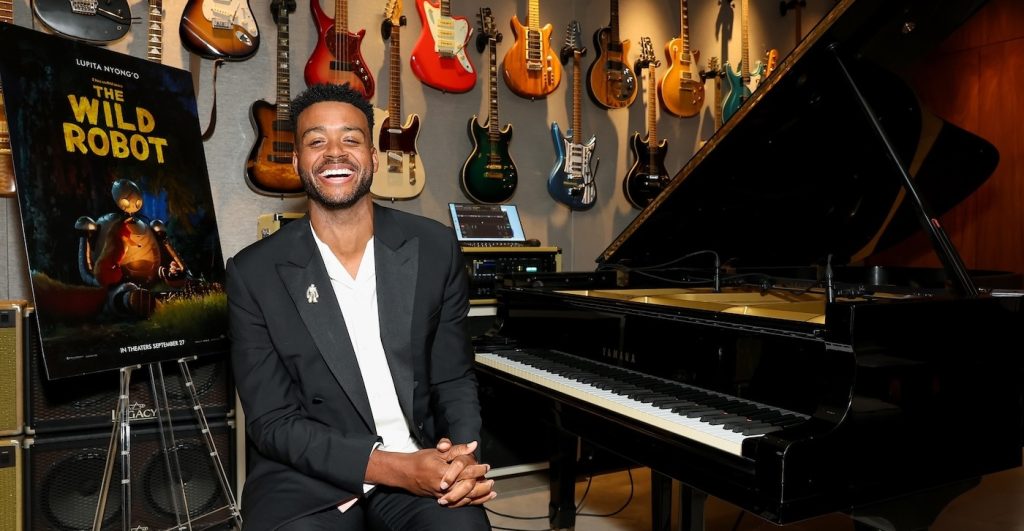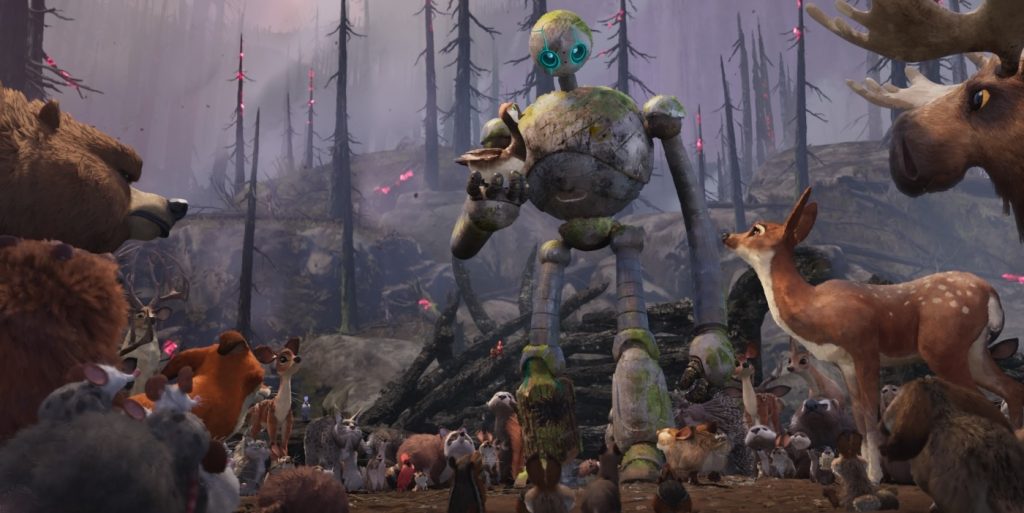“The Wild Robot” Composer Kris Bowers on Accessing a Robot’s Humanity Through Music
Emmy and Oscar-winning composer Kris Bowers has become one of the go-to composers in Hollywood. Known for his work on films and TV shows like King Richard, The Color Purple, The Last Repair Shop, and Bridgerton, he has created well-known scores for a wide diversity of genres. For writer/director Chris Sanders‘ The Wild Robot, Bowers has added feature animation to his list of credits. The music for the film has placed him as a leading contender for an Oscar nomination.
The Wild Robot tells the story of service robot Roz (voiced by Lupita Nyong’o), who must adapt to her new surroundings after being shipwrecked on an island inhabited only by its native animals. That includes orphaned gosling Brightbill (voiced by Kit Conor), who she builds a parental bond with as she works to prepare the undersized goose for winter migration.
The Credits spoke to Bowers about his foray into composing for animation, including his experience watching cartoons and how parenthood helped shape his emotional and spirited score for the film.

Early in the production, the first 20 minutes of The Wild Robot had almost no dialogue – and even the finished film has large swaths in which little is said. How did that impact the structure of your composition?
One of the things I looked forward to on The Wild Robot was knowing how much music can do in film and TV from watching cartoons when I was a kid. I remember sitting and watching Tom and Jerry, Silly Symphonies, and Looney Tunes, and seeing how much the music dictates the shape of how you feel. When Chris told me there would be these sequences that wouldn’t have much dialogue, it was just exciting for me to create something that was going to be very active while being supportive of the story and interesting compositionally enough that it doesn’t feel boring to listen to, while there’s nothing else going on, at least in terms of dialogue.

You have a theme for Roz that mirrors the fact she is technology in an organic environment. How did you approach the way she starts to merge with her environment and become more organic over the course of the story?
With Roz’s theme, I was actually thinking a lot about these products that we interact with. When Lupita talks about her voice work, which is so incredible and very subtle, she says she began trying to emulate what she calls this programmed optimism that you hear in Siri and Alexa. They always sound very bright, bubbly, and happy. She starts in that place and then continues to add her own warmth and humanity to the sound. With that in mind, for Roz’s theme, we started with a piece that could function as her commercial music, which she plays off of her speaker at the very beginning of the film. We wanted to have a little chime like your LG washing machine, so there’s a little thing that plays that is her “task acquired” chime, and then there’s a B side to her theme that, for me, represents the moments where she’s going beyond her programming. You hear that in the rescue mission and in the more heroic aspects of the winter storm. The main theme started as advertising music, and then I tried to see if that same melody would function as Roz became more.
Sandbox Percussion uses percussive elements based on more “found sounds,” like playing on tree branches and scrap metal. These are all live musical elements. In what practical ways did you collaborate with them?
When Chris and I discussed what the sound of the score would be, we talked about wanting to have this balance of the organic and the synthetic and something that represented the wild of the island. My first instinct, which was stereotypical, was to have ethnic flutes, but I immediately started questioning, “Where are we?” and “What culture is this?” Are we saying we’re in that place? So I wanted to find something with that kind of tactile quality but felt like you couldn’t place it in terms of geography. A friend of mine, classical composer Thomas Kotcheff, told me about Sandbox Percussion, a primarily classical percussion ensemble, but they play in this unorthodox way. It’s four guys, and they set up these crazy workstations that are tuned metal pipes, wood planks, an oxygen tank, and a tea kettle and tea cups and bottles. It’s more like foley and sound design, but then they play those as instruments.
How did you incorporate their instrumentation with your own choices?
First I wrote a demo cue to experiment with their sound, then I also wrote music to the raccoon sequence early in the film, where the raccoons are stealing part of Roz’s body, and I thought those would be two great moments to have this tactile sound. I took those recordings and made my own library, essentially, to use with their sound throughout the rest of the film. Then we went back and recorded with them. For example, there was this sound I had been calling “the rusty bucket.” We were trying to figure out what that would be, and they’d say, “That sounds like a tam-tam played with a metal stick, but then we can also play a cymbal covered with a towel, and then we’ll do that together, and that’ll be the sound for the rusty bucket.”
It also feels like where they land in the mix is very intentional.
Exactly. There was a lot of collaboration to figure out how to reproduce some of these unorthodox percussion sounds creatively, but I recorded them separately, so they were functioning almost like ASMR on top of the orchestra. They were always mixed differently than all the other percussion, the orchestra, and everything else so that they had their own place to live in the soundscape.
How did the main theme used in the migration sequence develop or change over time? Was there trial and error?
I started working on the migration theme very early on because I wanted to make sure the main theme worked in the rest of the film. For the sequence where Roz is saying goodbye to Brightbill, I thought of what that experience would be like as a parent. My daughter was six months old, and I imagined dropping her off at college. I wrote this piece and shared it with Chris, and he said, “Yeah, that really isn’t right. You should try to imagine dropping your daughter off at college”, which, of course, was what I’d done. I realized that the video that played in my mind was really cute, with us waving at each other, and she’d look back, so I wrote this very sweet and nostalgic, jaunty piece. But Chris and I talked about what was happening at that moment in the film. They’re not saying goodbye or that they love each other, even though they may not see each other again. Going home, I imagined a different scenario and thought of all the inevitable complexities of what our relationship might be. No matter how hard I try, I’m going to fail her. There will be things she’ll have to forgive me for or that she has to accept about me. There are worst-case scenarios, but that’s also just part of parenting. With my own relationships with my parents, there are things I’m still trying to accept and deal with, and all those complexities brought completely different emotions. I tried again, and Chris said, “You’re really onto something here.”
The next step, then?
He told me to write away from the film, not to watch the sequence, but write, and he’d animate to that. That was really freeing and exciting to just work on building the music. So he then went to the editor, Mary Blee, and the animators and shaped it based on the music.
These days, that’s a rare gift.
Well, Chris comes from the days of 2D animation, having worked on movies like Beauty and the Beast, which speaks to his history. I found out recently that at Disney back in the day the director’s room was called “the music room,” because they were working with existing pieces of music, which is true too with Looney Tunes and music by folks like Carl Stalling. That explains his comfort with music coming first. He comes from a generation of animators who really believe music is essential to great animation. It’s just a pleasure to work with someone with that perspective.
The Wild Robot is in theaters nationwide and is now widely available on demand.
Featured image: (from left) Roz (Lupita N’yongo), and Brightbill (Kit Connor) in DreamWorks Animation’s Wild Robot, directed by Chris Sanders.



